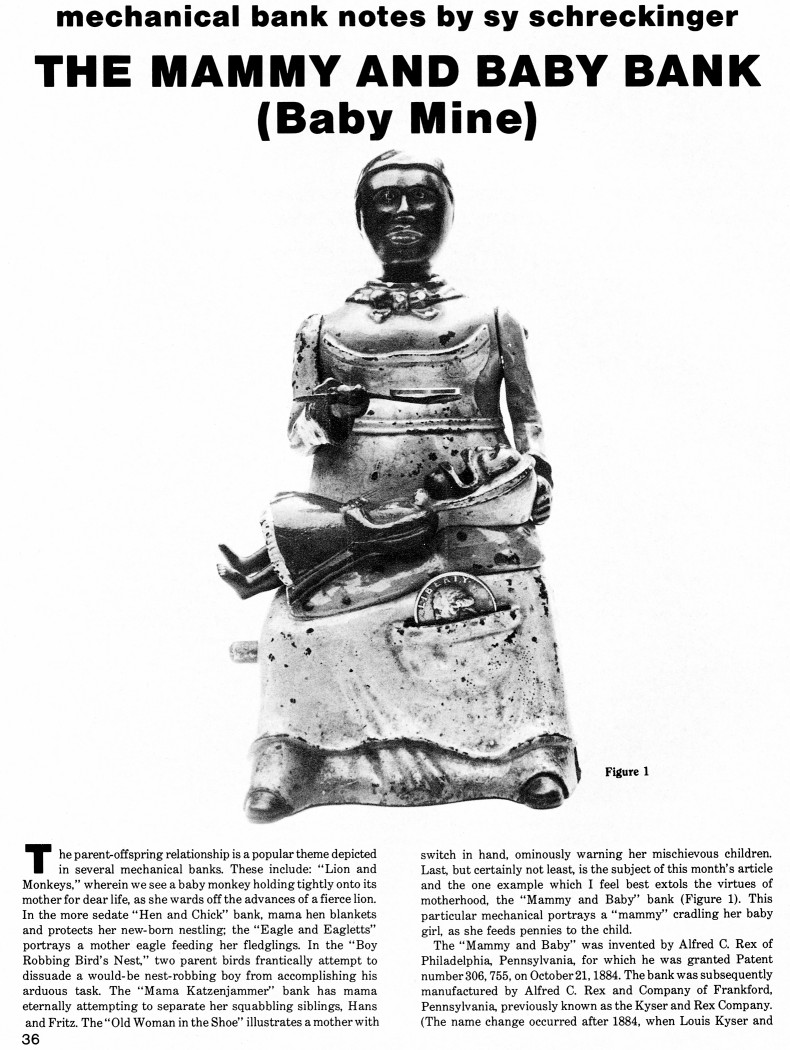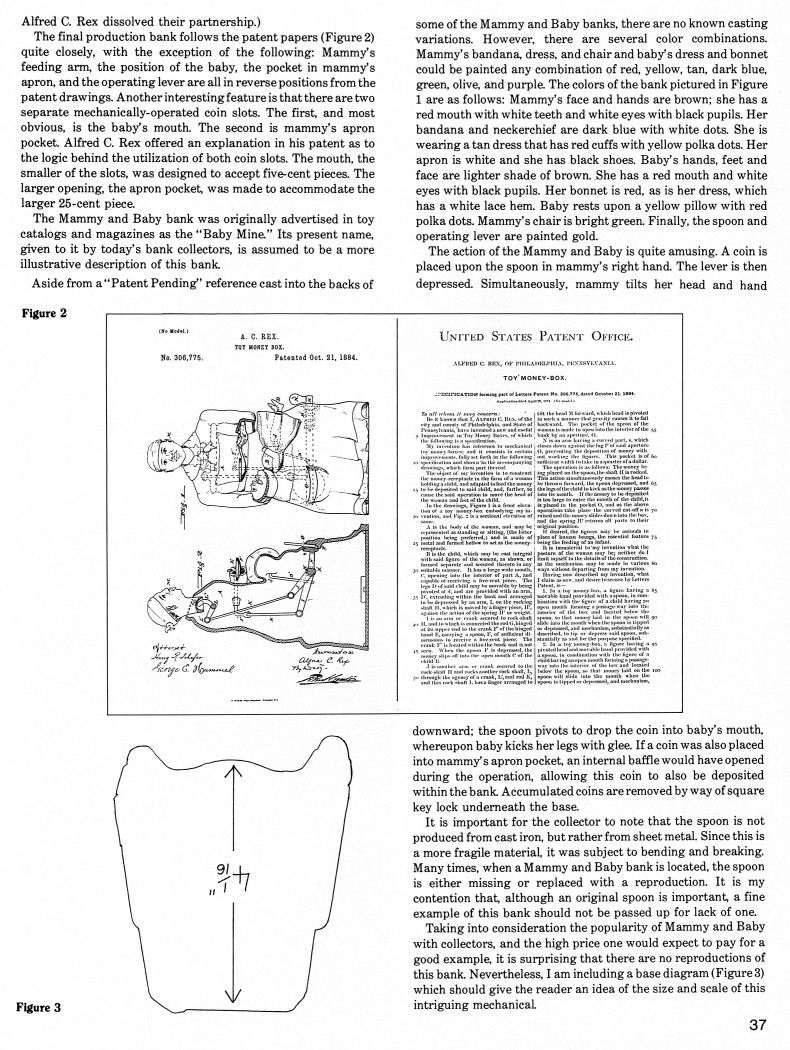|
The Mammy and Baby Bank
(Baby Mine)
by Sy Schreckinger – ANTIQUE TOY WORLD Magazine – January, 1987
The
parent-offspring relationship is a popular theme depicted in several
mechanical banks. These include: "Lion and Monkeys," wherein we see a baby
monkey holding tightly onto its mother for dear life, as she wards off the
advances of a fierce lion. In the more sedate "Hen and Chick" bank, mama
hen blankets and protects her new-born nestling; the "Eagle and Eagletts"
portrays a mother eagle feeding her fledglings. In the "Boy Robbing Bird's
Nest," two parent birds frantically attempt to dissuade a would-be
nest-robbing boy from accomplishing his arduous task. The "Mama
Katzenjammer" bank has mama eternally attempting to separate her
squabbling siblings, Hans and Fritz. The "Old Woman in the Shoe"
illustrates a mother with switch in hand, ominously warning her
mischievous children. Last, but certainly not least, is the subject of
this month's article and the one example which I feel best extols the
virtues of motherhood, the "Mammy and Baby" bank (Figure 1). This
particular mechanical portrays a "mammy" cradling her baby girl, as she
feeds pennies to the child.
The "Mammy and Baby" was invented by Alfred C. Rex of Philadelphia,
Pennsylvania, for which he was granted Patent number
306,775, on October
21, 1884. The bank was subsequently manufactured by Alfred C. Rex and
Company of Frankford, Pennsylvania, previously known as the Kyser and Rex
Company. (The name change occurred after 1884, when Louis Kyser and Alfred
C. Rex dissolved their partnership.)
The final production bank follows the patent papers (Figure 2) quite
closely, with the exception of the following: Mammy's feeding arm, the
position of the baby, the pocket in mammy's apron, and the operating lever
are all in reverse positions from the patent drawings. Another interesting
feature is that there are two separate mechanically-operated coin slots.
The first, and most obvious, is the baby's mouth. The second is mammy's
apron pocket. Alfred C. Rex offered an explanation in his patent as to the
logic behind the utilization of both coin slots. The mouth, the smaller of
the slots, was designed to accept five-cent pieces. The larger opening,
the apron pocket, was made to accommodate the larger 25-cent piece.
The Mammy and Baby bank was originally advertised in toy catalogs and
magazines as the "Baby Mine." Its present name, given to it by today's
bank collectors, is assumed to be a more illustrative description of this
bank.
Aside from a" Patent Pending" reference cast into the backs of some
of the Mammy and Baby banks, there are no known casting variations.
However, there are several color combinations. Mammy's bandana, dress, and
chair and baby's dress and bonnet could be painted any combination of red,
yellow, tan, dark blue, green, olive, and purple. The colors of the bank
pictured in Figure 1 are as follows: Mammy's face and hands are brown; she
has a red mouth with white teeth and white eyes with black pupils. Her
bandana and neckerchief are dark blue with white dots. She is wearing a
tan dress that has red cuffs with yellow polka dots. Her apron is white
and she has black shoes. Baby's hands, feet and face are lighter shade of
brown. She has a red mouth and white eyes with black pupils. Her bonnet is
red, as is her dress, which has a white lace hem. Baby rests upon a yellow
pillow with red polka dots. Mammy's chair is bright green. Finally, the
spoon and operating lever are painted gold.
The action of the Mammy and Baby is quite amusing. A coin is placed
upon the spoon in mammy's right hand. The lever is then depressed.
Simultaneously, mammy tilts her head and hand downward; the spoon pivots
to drop the coin into baby's mouth, whereupon baby kicks her legs with
glee. If a coin was also placed into mammy's apron pocket, an internal
baffle would have opened during the operation, allowing this coin to also
be deposited within the bank Accumulated coins are removed by way of
square key lock underneath the base.
It is important for the collector to note that the spoon is not
produced from cast iron, but rather from sheet metal. Since this is a more
fragile material, it was subject to bending and breaking. Many times, when
a Mammy and Baby bank is located, the spoon is either missing or replaced
with a reproduction. It is my contention that, although an original spoon
is important, a fine example of this bank should not be passed up for lack
of one.
Taking into consideration the popularity of Mammy and Baby with
collectors, and the high price one would expect to pay for a good example,
it is surprising that there are no reproductions of this bank.
Nevertheless, I am including a base diagram (Figure 3) which should give
the reader an idea of the size and scale of this intriguing mechanical.
|


